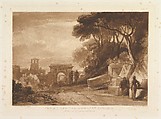Christ and the Woman of Samaria, part XIV, plate 71 from "Liber Studiorum"
Designed and etched by Joseph Mallord William Turner British
Engraver Samuel William Reynolds, the elder British
Publisher Joseph Mallord William Turner British
Not on view
Turner distilled his ideas about landscape In "Liber Studiorum" (Latin for Book of Studies), a series of seventy prints plus a frontispiece published between 1807 and 1819. To establish the compositions, he made brown watercolor drawings, then etched outlines onto copper plates. Professional engravers usually developed the tone under Turner's direction and Reynolds here added mezzotint to describe a scene from the Gospel of John 4:4-26, where Jesus encounters a Samitarian woman by a well. After asking for a drink, he reveals that his teachings offers sustenance of a different type. Approaching figures on the road represent the disciples returning from town with food, while the classical setting derives from a work by Poussin, and the letter "H" in the upper margin places the work within Turner's category of Historical landscape.
Due to rights restrictions, this image cannot be enlarged, viewed at full screen, or downloaded.


